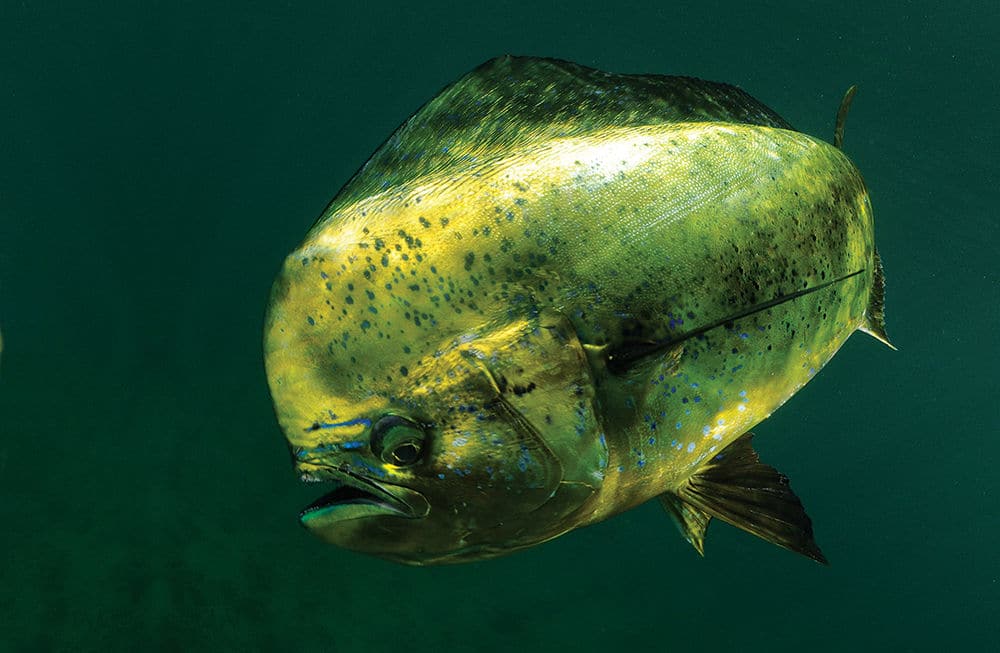Digging Deep Into Gulf Yellowfin
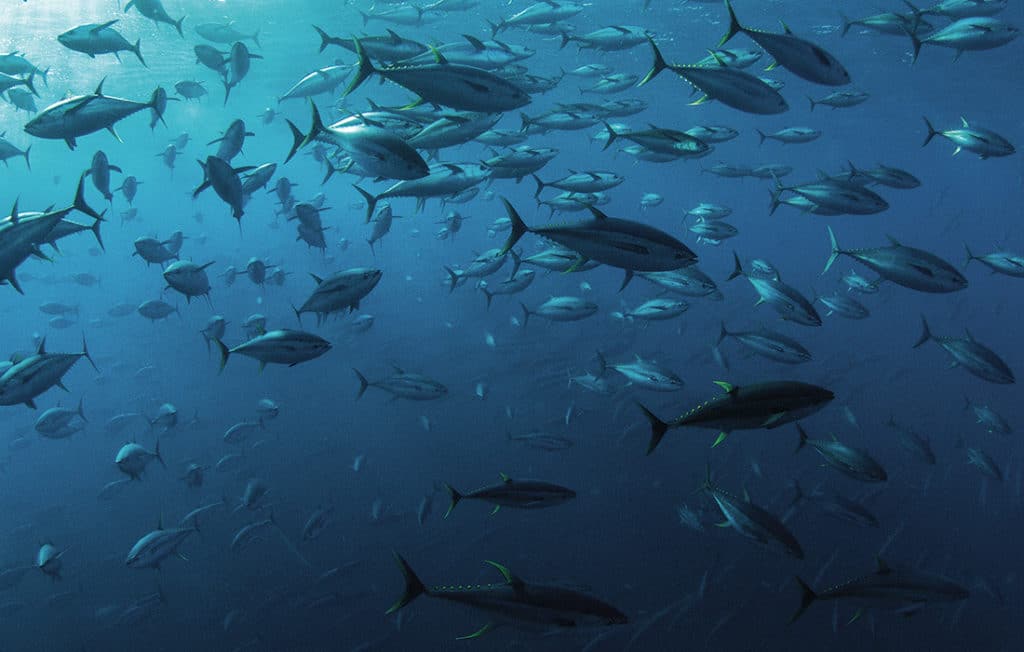
The total catch of yellowfin tuna in the western Atlantic is a daunting figure, with more than 101,305 tons reported in 2014. Fifty countries participating in a member treaty group called the International Commission for the Conservation of Atlantic Tunas (ICCAT) contribute to the total catch each year. Spain and France are some of the largest contributors, whereas the U.S. landed just 2.63 percent of the Atlantic-wide estimated total catch in 2014.
So, for a single state agency to try to affect international management might seem like folly. However, regionally in the northern Gulf of Mexico, with respect to yellowfin tuna catch, Louisiana is huge. More yellowfin tuna are landed both recreationally and commercially from ports in Louisiana than from any other Gulf Coast state. When fisheries managers in Louisiana looked at how the Atlantic-wide yellowfin tuna fishery was managed and what data was being collected from the local fishery, they realized they could make a difference.
Starting at the Single-Stock Hypothesis
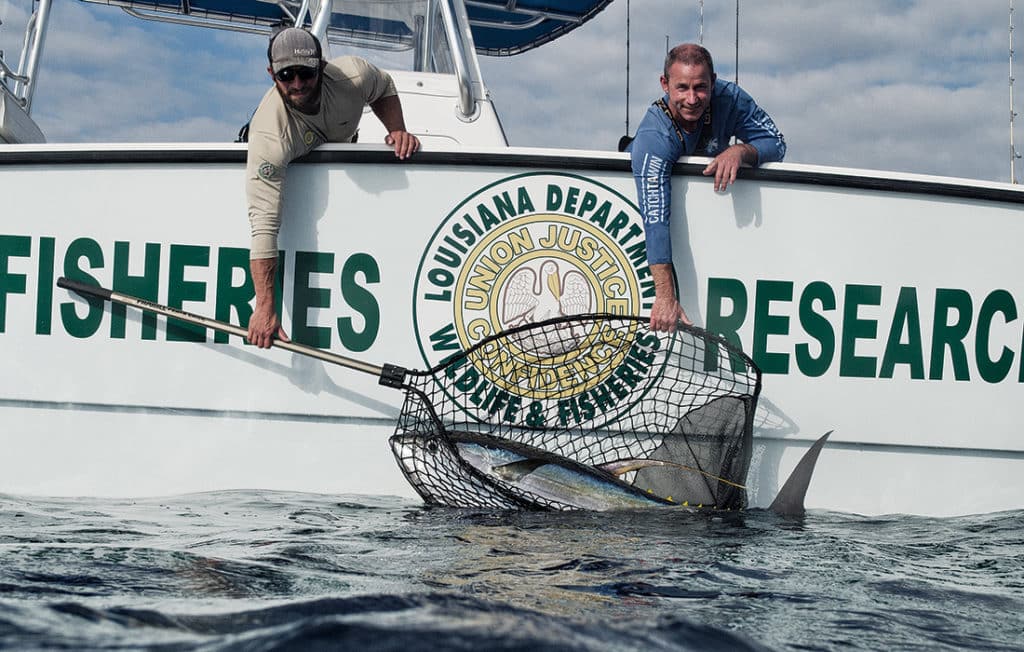
ICCAT — and thereby NOAA’s National Marine Fisheries Service, since the U.S. is a contracting party — manages yellowfin tuna in the Atlantic Ocean as a single stock. Furthermore, the management plan rests on the premise that production of yellowfin tuna is centered in waters off the Gulf of Guinea, a known tuna nursery in the eastern Atlantic adjacent to west-central Africa. The region supports a large purse-seine fishery that targets small tunas associated with fish-attracting devices (FADs).
The retention of undersize tuna by these purse seiners has long been a matter of contention among ICCAT nations, and the U.S. has lobbied for decades to force compliance with ICCAT minimum-size limits of 27 inches, fork length. Trans-Atlantic movements of yellowfin tuna have been documented by previous conventional-tag-recapture studies. Similarly, one-year-old bluefin tuna were documented crossing the Pacific Ocean in just a matter of months.
Still, is the health and future of the fishery in the Gulf of Mexico really dependent on what comes across the Atlantic? The answer might be in the tuna-rich Gulf waters off Louisiana.
The Unique Louisiana Fishery
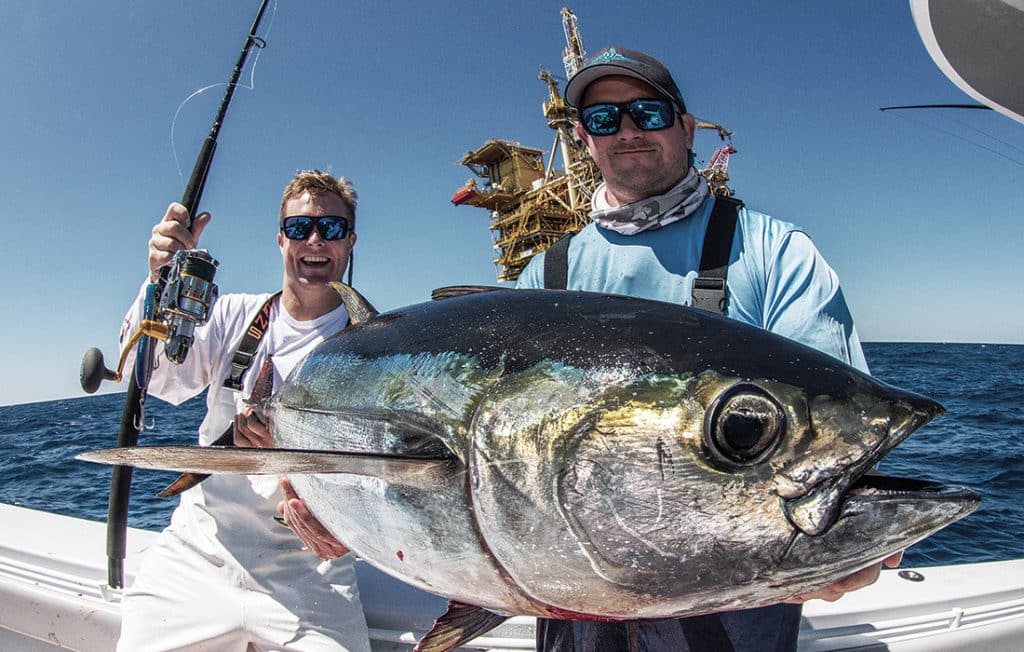
What is unique about Louisiana’s yellowfin fishery? I’d say almost everything, from environment to tuna behavior.
North America’s largest river flows out against Gulf Stream eddies (the Loop Current), and these currents meet above deep nearshore canyons along a shelf margin that is littered with FADs (oil rigs). Yellowfin tuna recreational catches out of Louisiana on a day trip can, at times, resemble what you’d see on a Pacific long-range tuna trip off Mexico.
But one thing that really stands out is the lengthy season: You can catch yellowfin tuna off southeast Louisiana all year. Whether anglers are live-bait fishing near rigs, chumming by shrimp boats or natural bottom features, or throwing topwater lures near surface-feeding whale sharks, there’s always action available.
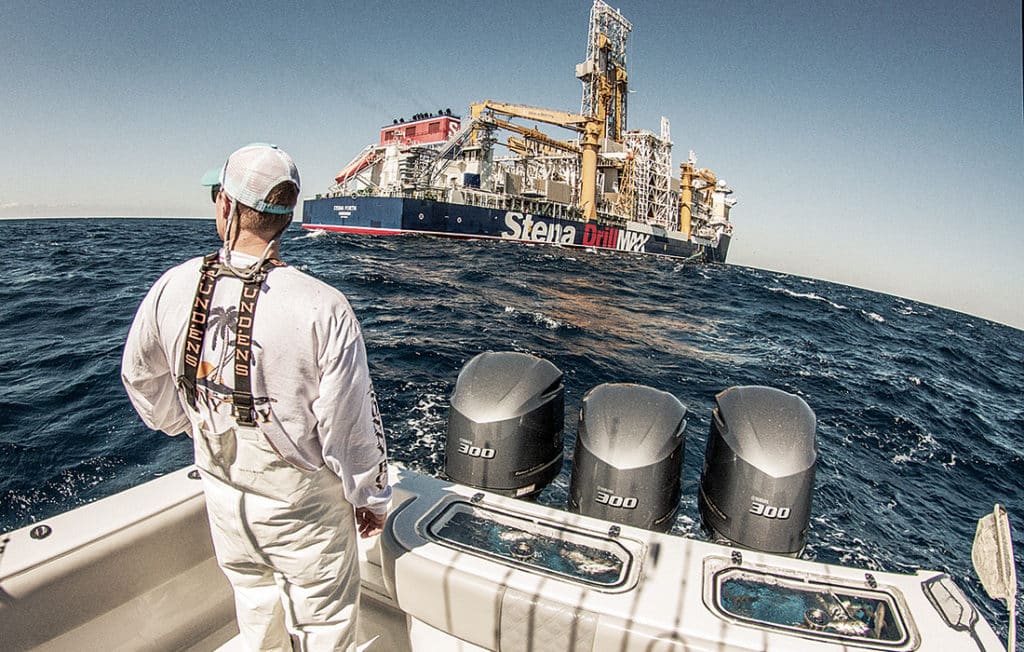
Clues about the yellowfin tuna’s life history are present as well: adults in spawning condition, day-old larvae caught during surveys, juvenile tunas just months old, and multiyear tag returns from adults recaptured in almost the exact same area they were released. The data suggests that some yellowfin tuna might spend a whole lifetime in the Gulf of Mexico. Perhaps not the picture you’d expect for a highly migratory species?
In response to the disparity between the importance of Gulf of Mexico yellowfin tuna to Louisiana-based user groups and the lack of biological information, the Louisiana Department of Wildlife and Fisheries (LDWF) began a comprehensive yellowfin-research program.
The success of the program ultimately hinged on access. LDWF dock samplers were able to provide biological samples from more than 1,600 yellowfin in less than three years. In excess of 200 yellowfin tuna were fitted with electronic tags. And about 400 young-of-the-year tuna were collected throughout the Atlantic.
Electronic Tagging
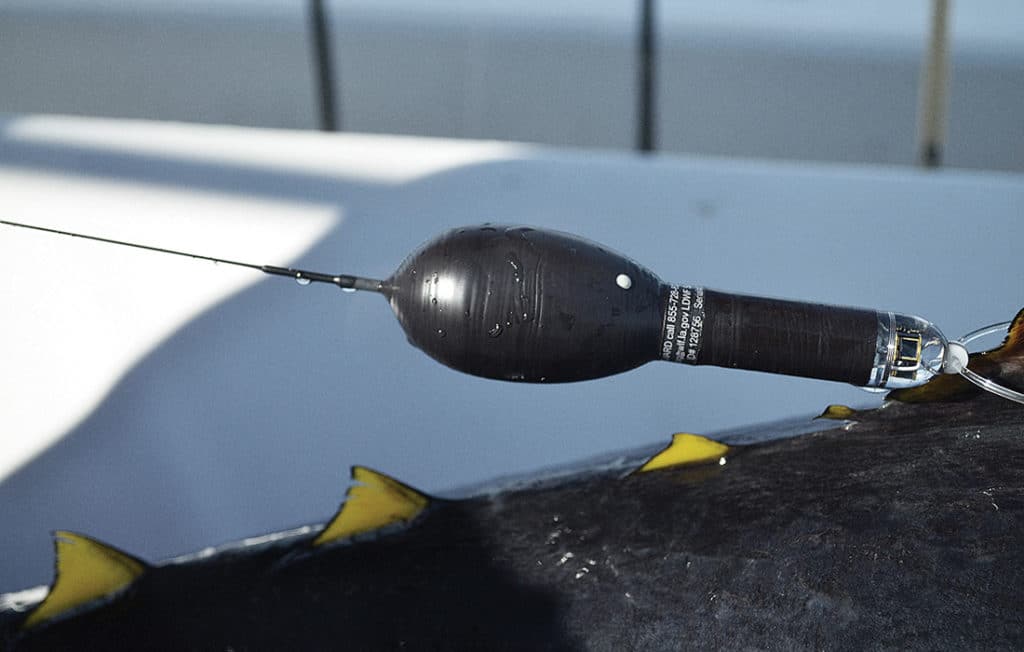
Conventional dart or spaghetti tags have been used for decades and are great tools for studying the movement patterns of fish. Fish have to be both recaptured and then reported for these projects to work. But pelagic fish such as tuna typically have very low recapture rates. In fact, according to the NMFS Cooperative Tagging Center, the all-time recapture rate for yellowfin tagged in the northern Gulf of Mexico is a tick above 2 percent.
Pop-off ARGOS satellite tags (PSATs) provide a way to track fish without relying on their recapture. But attaching PSATs to yellowfin tuna has been problematic for many researchers, possibly because of both their behavior and somewhat delicate bodies. Tuna must keep moving.
As anyone who has fished for or caught a yellowfin tuna can tell you, they’re extremely active in the water column, cumulatively traveling literally tens of thousands of vertical feet a day (as documented with depth records from PSATs). Average retention of satellite tags on yellowfin tuna in previous studies has been about a month.
Since the goal of the LDWF project was to look at long-term movements, it made sense to do two things differently from the start. The first was to figure out a better way to attach PSATs to yellowfin tuna. The second was to take a chance on a different electronic-tag type that had never been used on yellowfin tuna in the Atlantic.
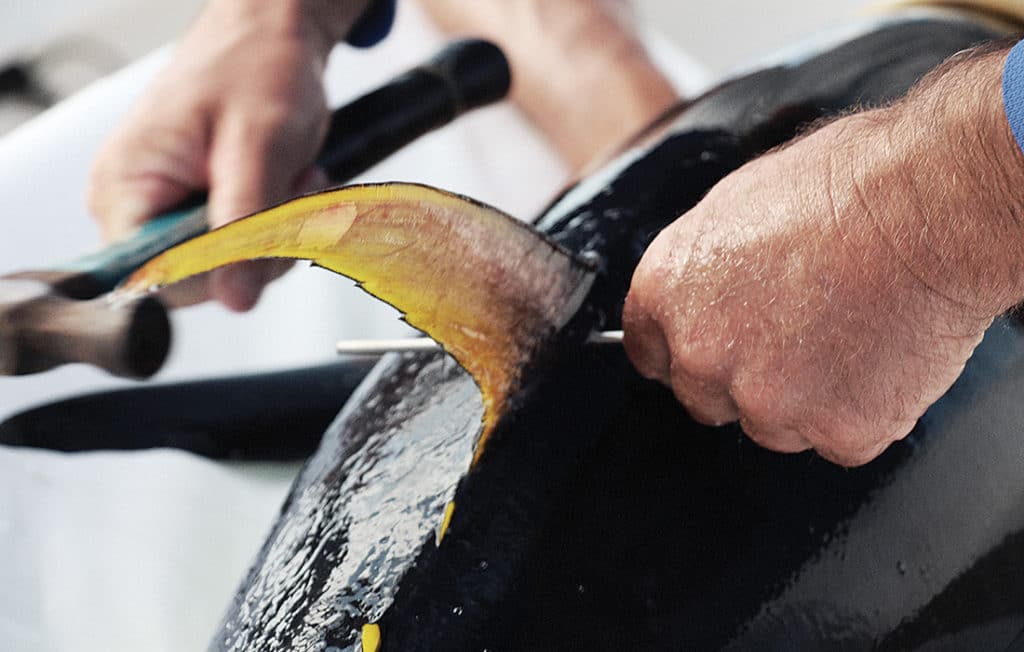
Improving tag attachment involved abandoning the use of darts to hold the buoyant satellite tags in the fast-swimming tunas. Instead, a hollow needle was used to target one of the heaviest areas of bone mass in a tuna’s body, which is the base of the second dorsal, known as the allison fin. Researchers passed heavy monofilament through the bony base of the second dorsal fin twice in a figure-eight configuration and crimped directly to the PSAT.
Like PSATs, internal archival (IA) tags are electronic tags that measure light level, depth and temperature. Both electronic-tag types can be employed for high-resolution studies of habitat use, as well as to re-create daily positions based on light-level measurements. Light-based geo-location works because sunrise and sunset times vary east to west, and day length varies north to south.
But unlike PSATs, IA tags use all their battery power to log data. Since they don’t use any of it for the pop-off mechanism or to upload the data through an antenna to a satellite system, they have a much longer lifetime. Some IA tags can log data for more than 10 years. Also, the internal tags have to be surgically implanted. Yellowfin tuna that are to be tagged are caught quickly so they’re in good condition, netted and placed upside down in a padded cradle. A small incision is made in the belly, and the internal tag is inserted into the body cavity. Two quick sutures hold the incision closed.
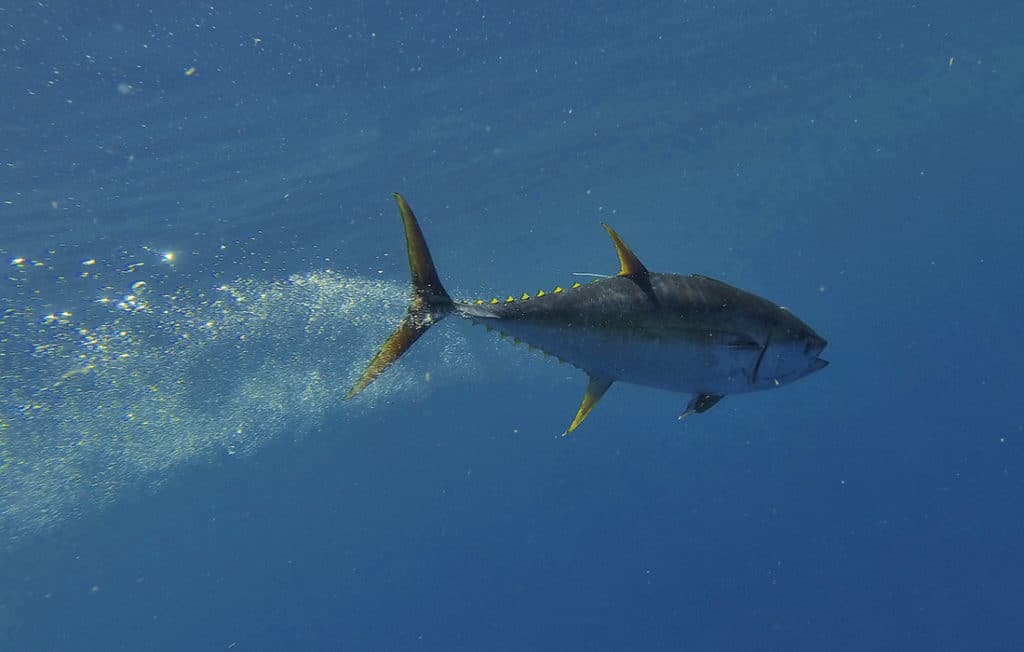
The light stalk of the tag protruding from the tuna’s abdomen and a green-and-white conventional tag near the dorsal fin are the only indications that the tuna is swimming around the Gulf with a computer in its belly. But the catch, literally, is that these fish have to be re-caught and reported for the data to be recovered from the tag. And while a 2 percent recapture rate might not justify a large investment in an internal-tagging project, LDWF biologists knew that the local recapture rate was closer to 10 percent based on conventional tags deployed on yellowfin as part of the Louisiana Cooperative Fish Tagging Program. So based on the hope of a slightly higher recapture rate in the region and that a $200 gift-card reward would incentivize participation, LDWF began tagging yellowfin in 2013 with internal and pop-off satellite tags in the north-central Gulf.
To date, 162 of these internal tags have been surgically implanted and 26 satellite tags attached to yellowfin tuna ranging in size from 27 inches to more than 160 pounds off southeast Louisiana by LDWF. Recapture rates have exceeded expectations, with 30 internally tagged fish recaptured to date. Some tuna were at large for up to 1,017 days, with the average returned IA tag having been in a fish for 238 days. And satellite-tag retention has more than doubled, with some satellite tags attached for more than 300 days.
The Results
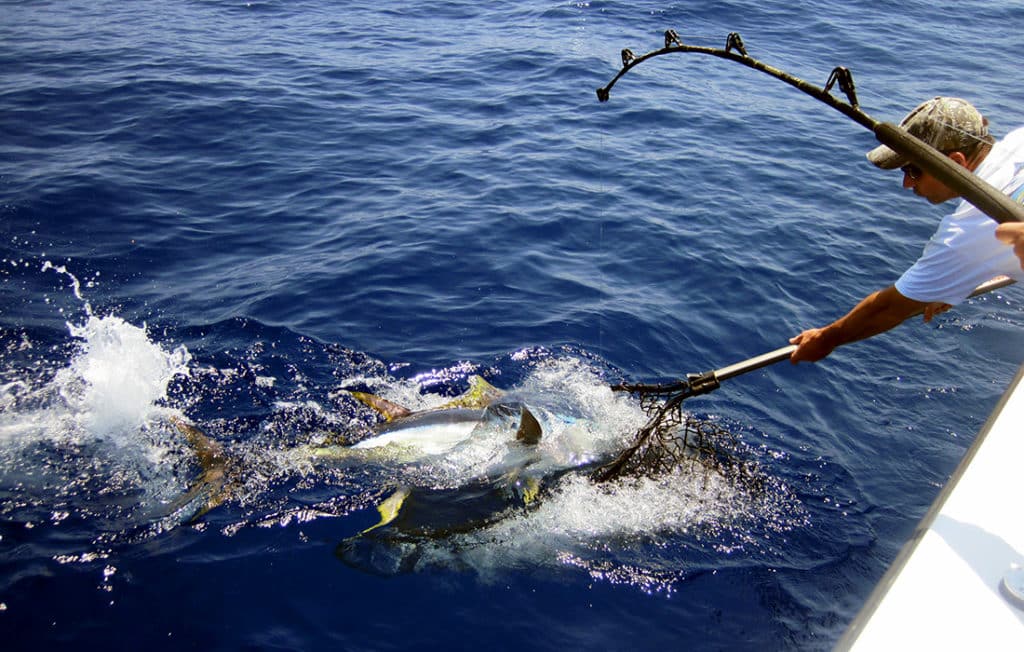
What’s the preliminary result? Almost 9,000 days of data across all tracked yellowfin tuna show that none have left the Gulf of Mexico.
We’re also seeing a high level of connectivity between fishing methods and locations, which hasn’t been previously documented. We’re looking to determine whether a fish’s tagging location has anything to do with its recapture location. It’s known that yellowfin tuna have a high level of association with structure, especially when they’re small, so it’s reasonable to wonder if that association might affect what other parts of the fishery you’ll see these same fish.
But so far a clear pattern has not emerged, with yellowfin tuna tagged at rigs being recaptured at the same rigs (where they were tagged) and other rigs, as well as shrimp boats and open-water schools and vice versa. And while we haven’t had any yellowfin tuna travel out of the Gulf, we have seen them recaptured by anglers off all Gulf states. Most recaptures have come from the Venice, Louisiana, charter fleet, but some have also come from Texas charter boats, Alabama private and charter boats, Florida private boats, and Gulf commercial pelagic longline vessels.
Another point to make here is that while tuna being captured at the same rig where they were tagged might not seem that interesting, remember that many of the offshore oil-field structures in the Gulf are mobile, like the drillship Ocean Black Rhino. So when some of the tuna tagged at one drillship were re-caught on the same drillship after it had moved more than 50 nautical miles, we were left to wonder if it’s really the fish doing all the moving or if their association with mobile structures might explain some of the dispersal patterns we’ve seen.
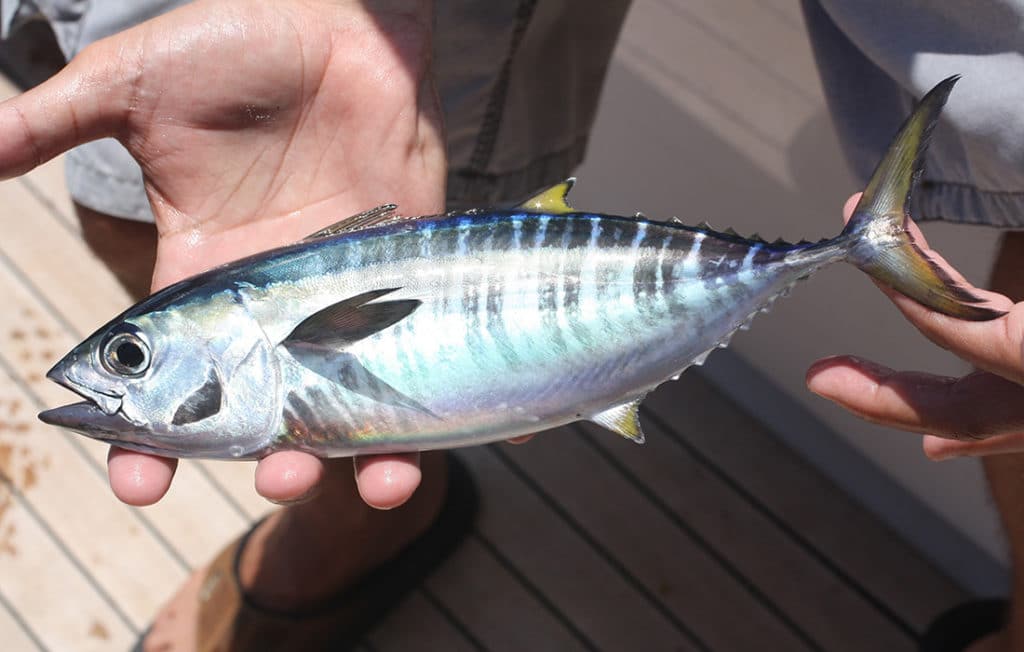
After three years of intensive study, a much more complete picture of the biology and life history of yellowfin tuna in the Gulf of Mexico has been uncovered. Not only do yellowfin tuna spawn off the Louisiana coast (see “Biological Research” sidebar), but that spawning activity helps to fuel the local fishery, which is composed of adults from both local and distant nurseries (see “Natural Tags” sidebar). And these tagging results suggest that no matter where the fish are spawned, once they end up in the Gulf, they’ll most likely stay around for a while.
When the previous Atlantic yellowfin tuna stock assessment was conducted in 2011, the Atlantic stock was found to be marginally overfished and possibly undergoing overfishing. The most recent stock assessment, which was just conducted in summer 2016, concluded that the fishery was overfished but that overfishing was not occurring. Data from several of the LDWF-coordinated projects were considered. And while the ICCAT continues to recommend a reduction in the mortality of small yellowfin, particularly in the FAD-associated fisheries in the eastern Atlantic, it is good to know that the regional fishery in the Gulf is not entirely dependent on foreign tuna-nursery grounds and their associated regulatory-compliance issues.
LDWF does not manage tuna, but the agency has certainly done its part to make sure the best science is made available to the federal and international managers of this fishery, which is in the best interest of all recreational and commercial fishermen.
Biological Research in the Gulf

Yellowfin tuna (Thunnus albacares) caught in the northern Gulf of Mexico recreational fishery were sampled as part of a life-history study funded by the Louisiana Department of Wildlife and Fisheries. Fisheries scientists Jim Franks, Nancy Brown-Peterson and Dyan Gibson, with the University of Southern Mississippi-Gulf Coast Research Laboratory, examined the feeding habits and reproductive biology of yellowfin tuna.
Examination of stomach contents from 1,286 yellowfin tuna (11 to 77 inches curved fork length, 12 to 221 pounds total weight) revealed a diverse diet comprised of 86 prey species, most of which were fishes and to a lesser extent invertebrates such as squid and offshore swimming crabs. More than 16,000 prey items were found in the stomachs. Some of the most common fish prey were menhaden, jacks, flying fish, mackerel, small tuna (including blackfins) and mullet, along with other prey including filefish, triggerfish, dolphin, snake mackerels, pufferfish, butterfish and spadefish.
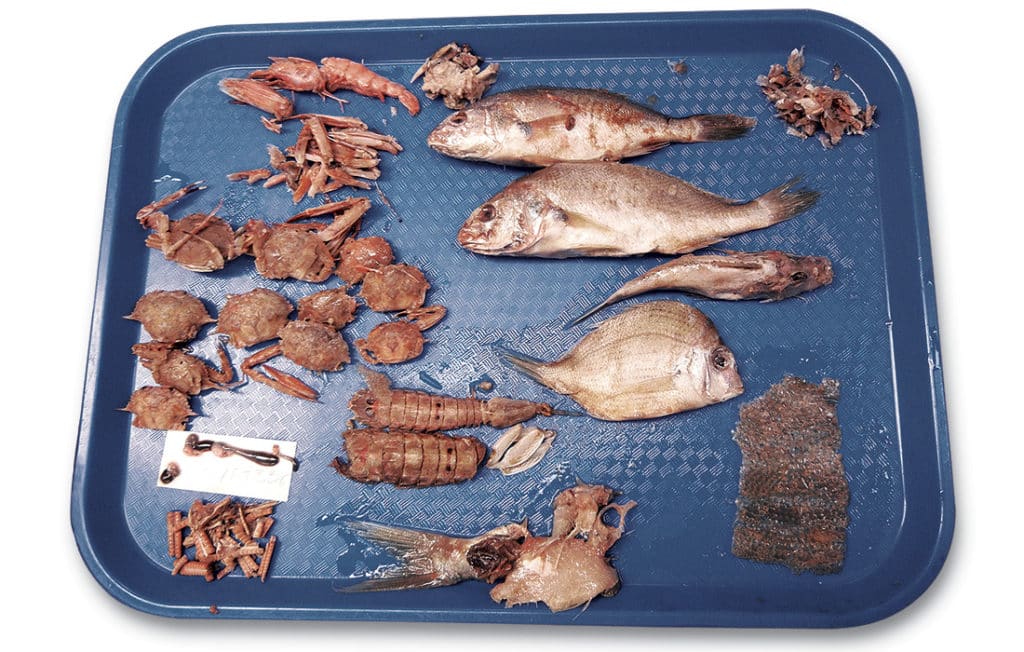
Seasonal shifts in yellowfin diet roughly correlated with the availability of certain prey species. For example, the fall and winter diet consisted of prey commonly associated with bottom habitats, including flatfish, sea robins, croaker and shrimp, which supports local knowledge that yellowfins feed on bycatch from shrimp trawlers working in the northern Gulf at that time.
An exhaustive examination of the reproductive biology of yellowfin tuna from the Gulf revealed that females spawn from mid-April through August. Individual females produce multiple batches of eggs and spawn as frequently as every 1.3 to 3 days, with younger fish spawning less frequently than older, larger females. Individual females can produce as many as 1,180,978 eggs per fish, and an average-size female of about 70 pounds can produce 25,586,823 eggs during a single reproductive season. The size at 50 percent sexual maturity, which is a term commonly used by fisheries managers to describe the size at which half the females in a population are mature, is 38 inches CFL, well above the current 27-inch minimum-size limit.
Natural Tags Help Resolve Yellowfin Origins
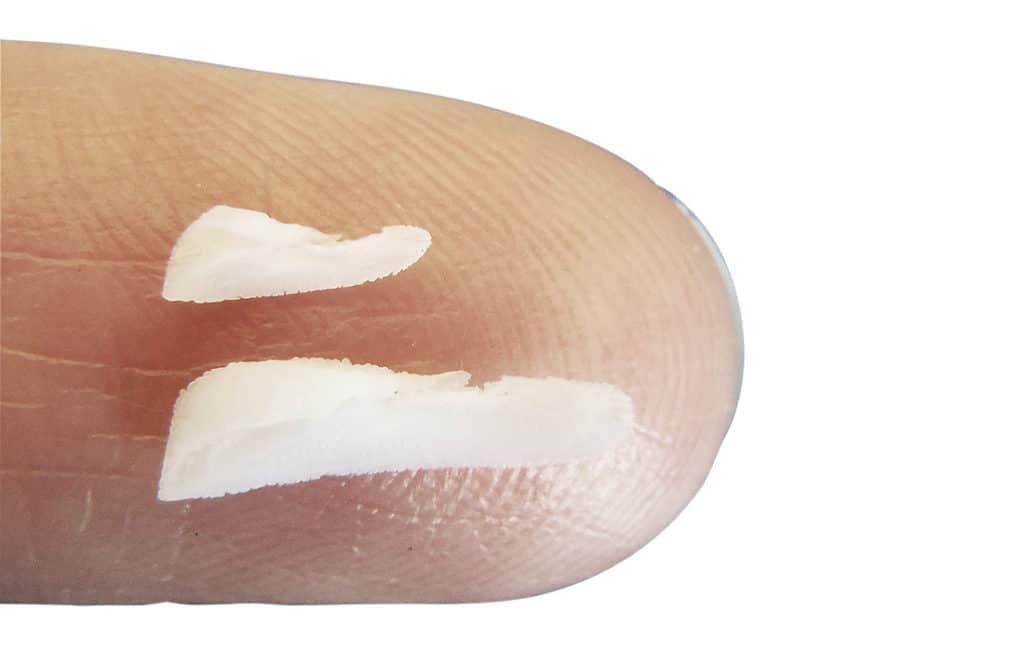
Doctorate student Larissa Kitchens from Dr. Jay Rooker’s Fisheries Ecology Lab at Texas A&M University is currently using chemical tags in ear bones (otoliths) to look at the stock structure and migration of yellowfin tuna in the Atlantic Ocean. The main goal of this project is to determine whether yellowfin tuna in the Gulf of Mexico are part of a resident population that spawns locally or if yellowfin migrate into the Gulf of Mexico from distant spawning areas.
Chemical concentrations in otoliths reflect the chemistry of the seawater the fish inhabit, so otoliths act as a natural tag that can be used as a chronological record of habitat use and movement. In this project, chemicals in the otoliths of juvenile yellowfin from all of the major nursery areas in the Atlantic Ocean will be used to create chemical signatures for each nursery. Then, otoliths from adult yellowfin caught in the Gulf of Mexico will be analyzed, and the chemistry of the otolith core — which corresponds to nursery period — will be matched back to the nursery signatures to determine where these fish were spawned.
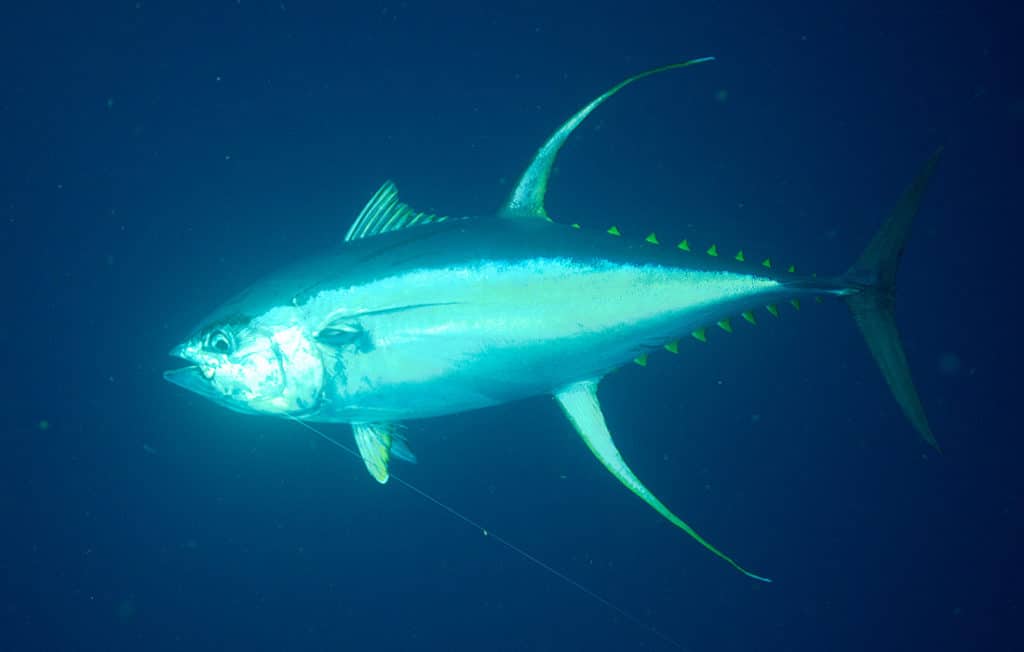
Results of this research will help to develop a better understanding of how valuable each of these nursery areas are to the Gulf of Mexico population. Preliminary results indicate that yellowfin tuna sampled from the Louisiana recreational fishery come from both distant and local nurseries. Ultimately, this information will improve the ability to effectively manage this important U.S. fishery and ensure that yellowfin tuna populations are sustainable.
About the Author: Brett Falterman is currently a program manager with the LDWF and oversees the state’s offshore fisheries independent monitoring surveys and research projects. With a graduate degree in marine science and more than 10 years of charter-fishing experience in the northern Gulf of Mexico, Falterman brings a unique perspective to addressing some of today’s challenges in fisheries management.
The Life and Times of the Dolphin
